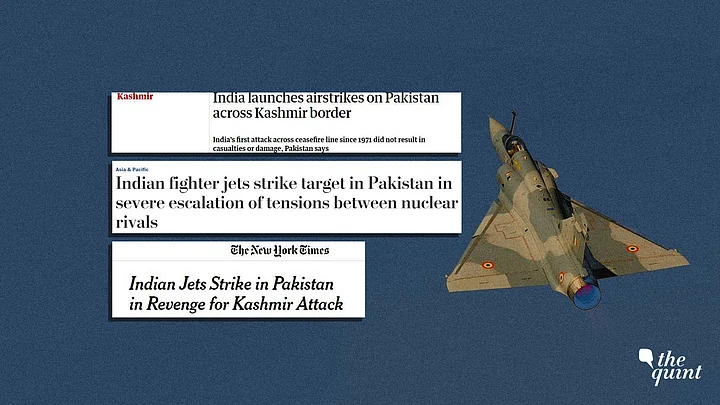The strategic air strikes conducted by the Indian Air Force across the LoC on Tuesday, 26 February, mark the first time that armed forces intentionally crossed the border since 1971, when it went to war with Pakistan.
Much has been said and debated about what this means for bilateral ties, the question of Pakistan’s sovereignty and India’s right to self defence.
In the middle of the melee, here’s how major international publications covered the air strikes. From calling it a ‘ severe escalation of tensions between nuclear rivals’ to ‘political symbolism’, here is what they said.
‘Targets of Indian Air Strikes Unclear’
The New York Times quoted Western security officials and analysts in Delhi to raise questions about the efficacy and targets of the IAF air strike.
‘Western security officials have raised questions about the existence of a large-scale training camp, saying that Pakistan no longer runs such camps and that militant groups are spread out in small groups around the country. Analysts and diplomats in New Delhi said the targets of the Indian airstrikes were unclear, as any terrorist groups operating along the border would have cleared out in recent days after Prime Minister Narendra Modi of India vowed retaliation over the Kashmir attack,’ reads an excerpt from the report.
They also cited the upcoming general elections to say that ‘voters have demanded that New Delhi respond to the Kashmir attack with force against Pakistan.’
‘Unclear if Operation had Been Carefully Calibrated to Ease Popular Anger’
In its report, The Guardian said the attacks had followed a ‘fortnight of sabre-rattling between the nuclear-armed neighbours’ and quoted representatives from India and Pakistan as part of their reportage.
Stating that it was still unclear whether anything significant had been struck down by the jets, the report went on to say that it was ‘unclear whether the operation had been carefully calibrated to ease popular anger over the 14 February suicide bombing’.
It also used the contradictory version of events put forward by the two countries to make a point about how India may have contained the scale of Pakistan’s response.
“The conflicting narratives over the attack echo the September 2016 “surgical strikes”, in which India claimed to have sent special forces to destroy militant facilities over the ceasefire border – an attack that Pakistan still maintains never happened. The varying positions allowed India to trumpet its reprisal against Pakistan without forcing Islamabad to respond in a way that might spiral into a larger conflict.”
‘Passions Were Running High in Both Countries’
Calling the air strike ‘the most serious escalation in hostilities between the two nuclear-armed neighbors in two decades,’ the report by The Washington Post maintained that the current clash seemed unlikely to intensify.
The report noted that the attack in Pulwama came before general elections later in the year and stated that the US administration had remained more or less supportive of India’s right to self defence.
So far, the United States has largely supported India in its quest to respond to the 14 February attack. Two days after the suicide bombing, John Bolton, the US national security adviser, said the United States supports “India’s right to self-defence”. Earlier this week, President Trump also referred to the possibility of an Indian response. “India is looking at something very strong,” Trump said, an impulse he said he understood, the article said.
‘Dramatically Escalating Tensions Between Nuclear-Armed Neighbours’
Quoting their own correspondent in New Delhi, Al Jazeera said that the Indian government had been under pressure to act in the wake of the Pulwama terror attack.
Al Jazeera’s Faiz Jamil, reporting from New Delhi, said that the Indian government has been under a lot of pressure to act in the wake of the Kashmir attack.“This attack was expected and one of the reasons it was delayed was the visit of the Saudi Crown Prince Mohammed bin Salman to the region,” Jamil said.“But everyone did expect that this would somehow happen sometime soon, especially with [general] elections coming up in April,” read the report.
‘Pak Officials Underplaying Severity by Describing it as a Strike "Across the LoC", not one Across the International Border’
BBC reported ‘a major escalation of tensions between the two countries’.
Quoting an analysis by M Ilyas Khan from Islamabad, the report read:
Pakistan has vowed to respond but this may not go beyond diplomatic measures. However, as some observers point out, there may be punitive attacks by militants against Indian forces in Kashmir “at an appropriate time”.
‘No Evidence was Immediately Provided to Back up the Claims of Militant Casualties’
Reuters reported that ‘there has been mounting impatience in India to avenge the 14 February attack, which was the most deadly seen in Kashmir during an insurgency that has last three decades, and as news of the raid broke, celebrations erupted across the country’.
The report also contained details of the alleged crash site in Pakistan and also quoted residents who reported fallen trees, craters and a damaged home: ‘Pakistani villagers in the area where the Indian jets struck said they heard four loud bangs in the early hours of Tuesday but reported only one person was wounded. “We saw fallen trees and one damaged house, and four craters where the bombs had fallen,” said Mohammad Ajmal, a 25-year-old who visited the site.
